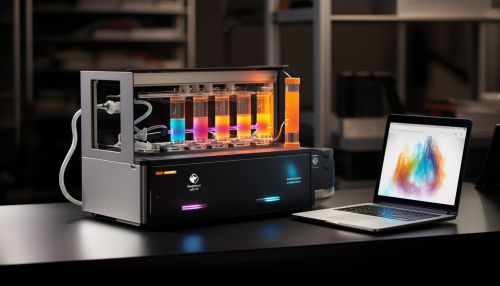Flow cytometry
Introduction
Flow cytometry is a biophysical technology employed in cell counting, cell sorting, biomarker detection, and protein engineering. This technique allows simultaneous multiparametric analysis of the physical and chemical characteristics of up to thousands of particles per second. Flow cytometry is widely used in the diagnosis of health disorders, especially blood cancers, but has many other applications in both research and clinical practice.
Principles of Flow Cytometry
Flow cytometry works on the principle of light scattering, fluorescence intensity, and, in some cases, electrical impedance. The sample is focused to ideally flow one cell at a time through a laser beam, where the light scattered is characteristic of the cells and their components. Cells are often labeled with fluorescent tags to make them stand out in the light.
Components of a Flow Cytometer
A flow cytometer is made up of three main systems: The fluidics system, the optics system, and the electronics system.
Fluidics System
The fluidics system is responsible for transporting the sample from the sample tube to the flow cell, where it is interrogated by the laser. The fluidics system also ensures that the cells are aligned correctly as they pass through the laser beam.


Optics System
The optics system consists of lasers, lenses, and filters. The lasers provide the light source that is used to excite the cells or particles in the sample. The lenses collect the light that is emitted or scattered by the cells, and the filters ensure that only the desired wavelengths of light are detected.
Electronics System
The electronics system consists of detectors, amplifiers, and analog-to-digital converters. The detectors convert the light signals into electronic signals, which are then amplified and converted into digital signals that can be processed by the computer.
Applications of Flow Cytometry
Flow cytometry has a wide range of applications in both research and clinical settings. These include cell counting, cell sorting, detection of biomarkers, and protein engineering.
Cell Counting
Flow cytometry is often used for cell counting. This is particularly useful in the diagnosis and monitoring of diseases such as leukemia and HIV/AIDS, where the number of certain types of cells in the blood can be indicative of the disease state.
Cell Sorting
Flow cytometry can also be used for cell sorting, where cells are separated based on their properties. This is useful in research settings, where specific cell populations may need to be isolated for further study.
Biomarker Detection
Flow cytometry is used in the detection of biomarkers, which are substances that can indicate the presence of a disease. This is particularly useful in the early detection of diseases such as cancer, where early treatment can significantly improve the prognosis.
Protein Engineering
Flow cytometry is also used in protein engineering, where it can be used to monitor the expression of different proteins in cells.
Advantages and Limitations of Flow Cytometry
Flow cytometry offers several advantages over other techniques for cell analysis. These include the ability to analyze multiple parameters simultaneously, the speed of analysis, and the ability to analyze individual cells. However, flow cytometry also has some limitations, including the need for expensive equipment and reagents, the requirement for skilled operators, and the potential for errors in data interpretation.
